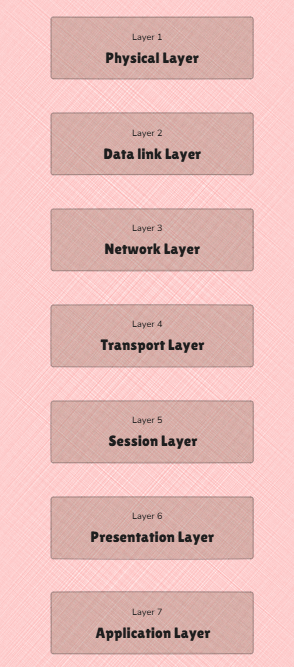Concept of Layering (OSI & TCP/IP Models)
Layering is a design principle used in networking to break down complex communication into simpler steps. It divides the network communication process into layers, where each layer has a specific role and talks only to the layers directly above or below it.
OSI Model (Open Systems Interconnection)
It breaks down the communication process into 7 layers, each with specific roles. OSI is theoretical model.

| Layer | Common Protocols | |
|---|---|---|
Application | Interfaces directly with end-user applications to provide network services. Ex - Web browsers, email apps, file sharing apps | HTTP, HTTPS, FTP, SMTP, POP3, IMAP, DNS |
Presentation | Translates data between the application and the network like handles encryption, decryption, compression, formatting and character encoding (e.g., ASCII, EBCDIC, Unicode). Ex - SSL/TLS for encryption, converting text to readable formats. | SSL, TLS, JPEG, MPEG, ASCII, EBCDIC |
Session | Manages sessions (connections) between applications like establishes, maintains, and terminates connections. Ensures both sides agree on when to start/stop sending data in complex interactions. Ex - Logging into a website or remote server | NetBIOS, PPTP, RPC, SMB, SIP |
Transport | Ensures reliable delivery of data end-to-end, manages flow control, error detection and retransmission. Port addressing to differentiate multiple applications running on the same host. Ex - Downloading a file, video streaming (buffering), gaming | TCP (connection-oriented, reliable), UDP (connectionless, less overhead, faster but no guaranteed delivery.), SCTP |
Network | Handles routing, path determination and routing decisions, and packet forwarding across networks. Assigns logical addresses (IP). Ex- Routers sending data to the correct destination | IP, ICMP, IGMP, IPSec, ARP, RIP, OSPF, BGP |
Data Link | Provides node-to-node data transfer, handles MAC addressing and error detection between devices on the same network. Ex - Wi-Fi access, LAN communication, Ethernet switching | Ethernet (802.3), Wi-Fi (802.11), PPP(Point-to-Point Protocol), HDLC, ARP, VLANs |
Physical | Deals with the physical connection between devices, transmitting raw bits over cables or wireless. Ex - Ethernet cables, fiber optics, radio signals | RJ45, USB, Bluetooth, DSL, coaxial, optical fiber |
Only Layers 1 to 4 (Physical, Data link, Network and Transport) are concerned with actual data transmission, while Layers 5 to 7 (Session, Presentation, and Application) handle how apps use and understand that data.
TCP/IP Model (Transmission Control Protocol / Internet Protocol)
The TCP/IP model is a simplified 4-layer model that describes how data is transmitted over the internet. It is the real-world implementation of networking. It maps closely to the OSI Model but with fewer layers. TCP/IP is practical and widely used. The Internet is based on TCP/IP.
Comparison to OSI
| TCP/IP Layer | OSI Layers |
|---|---|
Application | 7 – Application 6 – Presentation 5 – Session |
Transport | 4 – Transport |
Internet | 3 – Network |
Network Access | 2 – Data Link 1 – Physical |